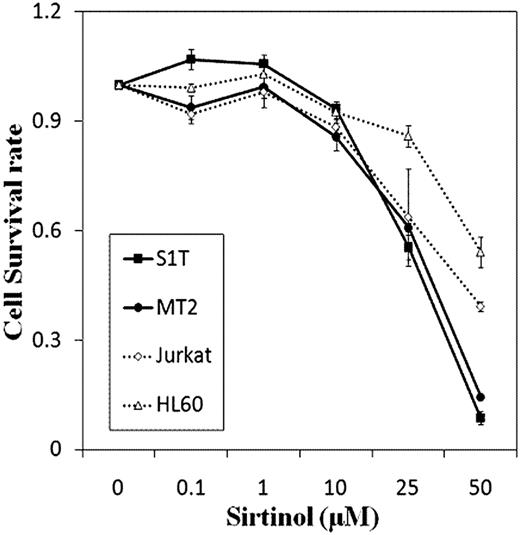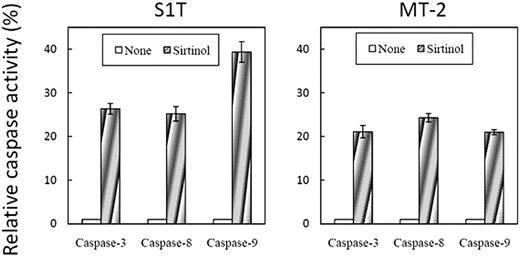Abstract
Abstract 3684
Poster Board III-620
Adult T-cell leukemia-lymphoma (ATL) is an aggressive peripheral T-cell neoplasm with a poor prognosis developing after long-term infection with human T-cell leukemia virus-1 (HTLV-1). HTLV-1 Tax is closely related to leukemic cell proliferation through nuclear factor-kappa B (NF-ƒÈB) activation. Recent studies have demonstrated that histone deacetylase class I/II inhibitors induce growth arrest and apoptosis of HTLV-1-infected T-cells via blockade of NF-ƒÈB signaling. SIRT1, an NAD(+)-dependent class III histone deacetylase, is widely recognized for its link to caloric restriction and longevity. SIRT1 plays a crucial role in a variety of physiological processes including metabolism, neurogenesis, cell survival, apoptosis and aging due to its ability to deacetylate numerous substrates such as histone, p53 and NF-ƒÈB. Existing reports on the role of SIRT1 in oncogenesis are controversial, with some evidence of an oncogenic role due to its increased expression in prostate cancer, acute myeloid leukemia and colon cancer, possibly mediated by inactivation of proteins involved in tumor suppression and DNA damage repair. Contrasting evidence of reduced SIRT1 expression in breast and hepatocellular carcinomas may support a tumor suppressor role, especially if the tumor is related to a p53 mutation. Such conflicting reports raise intriguing questions regarding its role in oncogenesis, and even less is known about its role in ATL in particular. We therefore set out to assess the expression of SIRT1 and the effect of its inhibition in HTLV-1 infected cell lines and ATL cells from patients. We observed SIRT1 protein and mRNA expression in ATL patient cells, an HTLV-1-infected cell line (MT-2), an ATL cell line (S1T), as well as HTLV-1 unrelated cell lines, Jurkat and HL60, as controls. SIRT1 expression in ATL patients was significantly higher than asymptomatic HTLV-1-carriers and healthy donors. The SIRT1 inhibitor, sirtinol, inhibited growth of all cell lines tested, with greater selectivity for HTLV-1 related cell lines (Figure 1) and ATL patients. Sirtinol induced apoptosis by activation of caspase-3, 8, 9 (Figure 2) and reducing IkBa phosphorylation, but did not significantly increase p53 acetylation in HTLV-1 infected cell lines. SIRT1 activation by NAD+ augmented apoptosis induction by sirtinol in MT-2 cells. These findings suggest that SIRT1 may be involved in T-cell immortalization by HTLV-1 and may be a crucial anti-apoptotic molecule in ATL cells. SIRT1 inhibition could therefore be useful in treating ATL.
Inhibitory effects of sirtinol, SIRT1 inhibitor, on cell viability of leukemic cell lines. Cell lines were treated with sirtinol (0, 0.1, 10, 25 and 50μM) for 24hr. Each bar represents the mean ±S.D. of 3 independent experiments.
Inhibitory effects of sirtinol, SIRT1 inhibitor, on cell viability of leukemic cell lines. Cell lines were treated with sirtinol (0, 0.1, 10, 25 and 50μM) for 24hr. Each bar represents the mean ±S.D. of 3 independent experiments.
The activities of caspase-3, 8 and 9 in S1T and MT-2. Cell lines were treated with sirtinol (50μM) for 6 hr. Each bar represents the mean ±S.D. of 3 independent experiments.
The activities of caspase-3, 8 and 9 in S1T and MT-2. Cell lines were treated with sirtinol (50μM) for 6 hr. Each bar represents the mean ±S.D. of 3 independent experiments.
No relevant conflicts of interest to declare.
Author notes
Asterisk with author names denotes non-ASH members.



This feature is available to Subscribers Only
Sign In or Create an Account Close Modal